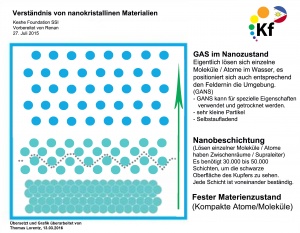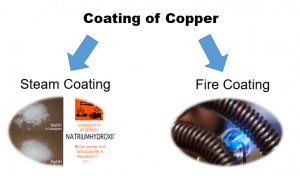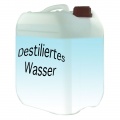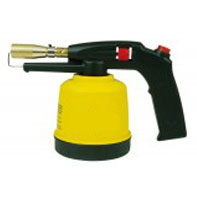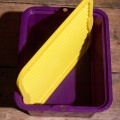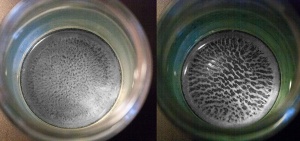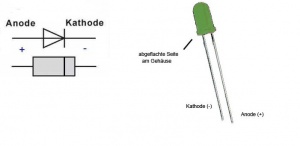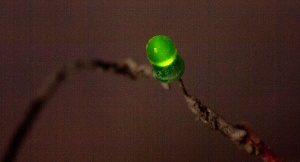Kategorie:Nanobeschichtung und GANS-Produktion
Hier finden Sie eine Sammlung von Informationen und Basis-Verfahren, um Kupfer zu beschichten, GANS zu erzeugen und dieses auch anzuwenden.
Inhaltsverzeichnis
Nanobeschichtung
Das Basismaterial für das Coaten ist Kupfer, egal in welcher Form. Das Coaten erfolgt entweder thermisch durch Erhitzen (Gasbrenner) oder chemisch durch Ätzen (NaOH). Im Zuge des Coatings entstehen "Lücken zwischen den Atomen" und auf der Kupferoberfläche bilden sich mikroskopisch kleine Schichten, die wiederum aus kleinen Partikeln bestehen, die wie Drähte aussehen, diese werden auch "nanowire" genannt, da sie so klein sind. Deshalb wird das Coating auch oft als Nano-Coating bezeichnet. Diese Nanoschichten haben die Eigenschaft, im Laufe der Coatings zu wachsen.
Nanobeschichtung mit NaOH
Um Kupferdraht oder Platten zu coaten, wird folgendes benötigt:
- Plastikbehälter mit Deckel (nicht zu groß)
- Gewichte zum Beschweren des Deckels
- fertig gewickelte Kupferspulen, Drähte oder Platten
- ~ 100 Gramm reines NaOH als Pulver oder Kügelchen(kein Abflussreiniger, u.a. in Farbengeschäften beziehbar, das es dort zum Ablaugen von Möbeln verwendet wird)
- ~ 2 Liter destilliertes Wasser (je nach Menge der Spulen und Größe der Plastikwanne)
- Wasserkocher oder Herd zum Erhitzen des Wassers
Phase 1: NaOH Bad (~ 2 Tage)
Folgende Schritte sind notwendig
- Ein zinkummantelter Eisendraht (z.B. galvanisierter Maschendrahtzaun) wird auf dem Boden des Containers platziert
- Das NaOH Pulver wird auf dem Boden verteilt.
- Die Spulen und/oder Platten werden direkt im Container befestigt und dürfen sich nicht berühren
- Der Deckel wird mit einem kleinen Spalt auf den Container gelegt
- Kochendes Wasser wird über diesen Spalt in den Container gegossen, bis alle Spulen und Platten vollständig mit Wasser bedeckt sind. Je heißer das Wasser, desto besser, die ersten Sekunden zählen hier!
- Der Deckel wird schnell geschlossen
- Wenn notwendig, werden Gewichte verwendet, um den Deckel zu beschweren
- Der geschlossene Behälter soll so mind. 24 Stunden an einem warmen Ort stehen bleiben (ideal über 25°C, am besten 30°C)
Achtung, währen dieses Vorganges entweicht Dampf, bitte Schutzgläser und Handschuhe tragen!
Phase 2: Wachstum der Nanoschichten (~ 2-4 Tage)
- Nach mind. 24 h, das Wasser, bis auf etwa 5mm vom Behälter entfernen.
- Weitere 24h an einem warmen Ort oder in der Sonne "brüten" lassen
- Alle etwa 6 Stunden den Behälter öffnen und bei Spulen beide Enden mit einem Multimeter (eingestellt auf mV) für etwa 5 Sekunden berühren, bei Platten an gegenüberliegenden Enden.
Phase 3: Gründliches Waschen
Nachdem der Prozess des Nanobeschichtens abgeschlossen ist, müssen die Platten gründlich mit warmen Wasser, mehrmals gewaschen werden
Nanobeschichtung mit Gasbrenner
Bei dieser Art des Coatens muss zwar anschließend keine Polarisation und Trocknung (+Potential abziehen) durchgeführt werden, dafür ist die Temperatur und Richtung des Feuercoatens ausschlaggebend. Die Bewegung während des Feuercoatens muss immer in Flussrichtung sein und die Drähte dürfen nie glühen. Sobald die Drähte einen goldenen Schein bekommen, sollte der Gasbrenner weiterbewegt werden.
Wenn die Drähte nach ein paar Sekunden Abkühlung durchgehend verschiedene Farben, wie rot, türkis oder blau annehmen, war die Temperatur zu niedrig, in diesem Fall einfach noch einmal über diese Passage drübercoaten. Beginnt der Draht zu glühen, ist die Temperatur zu hoch, in diesem Fall den Gasbrenner einfach ein Stück zurückbewegen und dann wieder erneut coaten. Mit der Zeit entwickelt sich ein Gespür für das Feuercoaten und alles läuft automatisch.
Wir benötigen:
- Gasbrenner mit Butangas (es funktioniert auch mit einer Propan/Butanmischung)*
- Kupferspulen oder -Platten
- Feuerfeste Befestigungsvorrichtung zum Aufhängen der Spulen oder Platten
Wichtig: Coaten Sie nicht in zu kalten Räumen, da sich sonst die Coatingschicht sehr leicht vom Kupferdraht löst, es gibt auch Qualitätsunterschiede bei den Kupferdrähten, manchmal sind bereits im "rohen" Zustand leichte Risse an der Oberfläche zu sehen.
* Bitte darauf achten, dass ein Gasbrenner verwendet wird, der eine sehr schmale Flamme produziert, um punktgenau arbeiten zu können, wie man es in dem Video dazu sieht. Bei einer zu breiten Flamme werden auch die Nachbarbereiche mit erhitzt, was die nötige Richtung des Erhitzungsvorgangs zunichtemacht!
When nano-coating copper using fire, it is done at least in two or more sessions depending on how consistent you become in each session. Between each session, the copper is allowed to cool at room temperature. During the cooling process the copper continues to interact with the atmosphere and you will begin to see a change in color on the surface of the copper. The reaction of the nano-coated copper during the succeeding sessions will be different compared to the first session when fire is first applied. On each succeeding session, the nano layer on the surface of the copper also acts as another layer of conductor and a heat sink. When the flame is applied, this surface layer will start to change into a dull color copper before reaching that right temperature of "shimmering surface" look. We still look for that "golden shimmering" moment as in the previous session and move the flame to the adjacent area. A third or more sessions is only required when you see inconsistency of nano-coating colors due to uneven lower heat application or flaking nano layers due to excessive heat application.
Important: For a magrav set of coils or multiple coils formation, the color of the inner coil (gravitational) and the color of the outer coil (magnetical) will usually manifest differently from each other due to the field interaction of the nano layers as they are created during the nano-coating process. Different materials (different batch of copper) will also have a different nano-coating layer. The environmental conditions (flame temperature, atmospheric air quality and temperature, plasma fields) during the nano-coating process greatly influence how the nano materials will manifest on the surface of the material like copper.
Erzeugung und Anwendung der 4 Grund GANS-Arten
GANS ist die Abkürzung für "GAs in Nano-state of Solid". Die Keshe Foundation hat ein Verfahren entwickelt, durch das Kohlenstoffdioxid (CO2) aus der Luft mit einfachen Mitteln extrahiert und in einen festen Zustand im Nanometerbereich (Nano-state of Solid) umgewandelt werden kann. Bei der Herstellung vom CO2-GANS wird der Kohlenstoff aus der Luft mit dem Sauerstoff in der Salzlösung in einer Art Plasma-Blase (aus Magnetischen und gravitativen Feldern) in eine besondere kristalline Form gebracht, wobei diese Kristalle das Licht (die Felder) absorbieren, speichern und bei „Bedarf“ abgeben. Jeder Kristall ist wie eine Sonne!
Des Weiteren hat die Keshe Foundation entdeckt, dass dieses GANS, sowohl getrocknet, als auch gebunden in Wasser, ein nützlicher Energielieferant ist, bzw. in Bereichen der Gesundheit und Landwirtschaft nützlich eingesetzt werden kann. Das aus dem GANS gewonnene GANS-Wasser (= das klare Wasser, das sich in der Suspension aus GANS und destilliertem Wasser über dem abgesetzten GANS befindet, nachdem das GANS mindestens 5 bis 10 Mal mit destilliertem Wasser „gewaschen“ wurde – siehe Kapitel GANS waschen) kann auf unterschiedliche Weise verwendet werden. Es lassen sich daraus z.B. Bäder und Wundauflagen machen. Es kann auch als Spray benutzt werden und in kleinen Mengen bzw. in verdünnter Form (Liquid Plasma – siehe dort) auch eingenommen werden. Die Anwendungen sind nahezu grenzenlos und erst ansatzweise erforscht.
Das von der Keshe Foundation entwickelte Verfahren zur GANS-Gewinnung funktioniert nicht nur zur Erzeugung von CO2-GANS, sondern auch für andere "GANS-Arten". Die nebenstehende Abbildung zeigt schematisch die Entwicklung von GANS. Als Basis wird "rohes" Kupfer verwendet, abgebildet ist daher unten die kompakte Atomstruktur. Das Kupfer wird im ersten Schritt gecoatet. Durch das Coating entstehen die bereits erwähnten größeren Abstände zwischen den Atomen, es bilden sich Nanoschichten mit Nanowires (siehe Kapitel Coating). Dieses gecoatete Kupfer im Zusammenspiel mit einer Zinkplatte in Salzwasser das CO2-GANS, das sich am Boden absetzt.
GANS wird zum Betrieb der Keshe-Magravs benötigt. Einerseits werden die gewickelten und gecoateten Spulen damit beschichtet, andererseits befinden sich GANS-Behälter (z.B. Ping-Pong Ball) in der Mitte der Spulen bzw. wird das GANS benötigt, um daraus GANS-Wasser und daraus wiederum GANS-Felder herzustellen. Diese GANS-Wässer sind in vielen Bereichen der Gesellschaft einsetzbar. Wir beschreiben hier lediglich die Herstellung der vier Grund-GANS-Arten durch Eintauchen von gecoateten Kupfer-Drähten bzw. gecoateten Kupfer-Platten und verschiedenen Metallen in 5-10%igem Salzwasser (50-100 Gramm Salz in 1l destilliertem Wasser aufgelöst). Somit benötigen Sie zur GANS-Gewinnung:
Materials required for the production of GANS:
- Plastikbehälter
- Destilliertes Wasser
- Salz
- Nanobeschichteter Draht zum Verbinden von Platten oder Spulen
- Nanobeschichtete Platten oder Spulen
- Verschiedene Metalle, wie Zink, Kupfer oder Eisen, die für die Produktion der verschiedenen GANSe verwendet werden
Diese Tabelle gibt einen Überblick über die 4 Grund GANS-Arten:
| GANS | Color | Coated Material | Uncoated Material | salt content |
|---|---|---|---|---|
| CO2 (ZnO + CO2) | Cremeweiß | nanobeschichtetes Kupfer | Zink | 5-10% |
| ZnO | Weiß | nanobeschichteter Zink | Zink | 5-10% |
| CH3 (FeO + CH3) | Bräunlich | nanobeschichtetes Kupfer | zinkumhülltes Eisen (häufig bei Zäunen) | 5-10% |
| CuO (CuO + Cu) | Türkis | nanobeschichtetes Kupfer | Zink | 5-10% |
Wichtig: Wenn verschiedene GANSe erzeugt werden, dann sollte zwschen den Produktionsbehältern ein Abstand von 2-5m gehalten werden, um gegenseitige Beeinflussung zu vermeiden.
CO2-GANS

Production
CO2 GANS is produced by placing a zinc plate, connected to a nano-coated copper coil or nano-coated copper plate, in a sea salt water solution. Dissolve 100 grams of sea salt in a liter of distilled water and pour the solution into a GANS collection container. Ensure all of the salt is dissolved. There are different ways in which to connect the zinc and copper plates or coils together, which will affect the ratio of CO2 to Zinc GANS produced. In the following video Keshe explains in detail how to produce CO2-Gans:
CO2/ZnO GANS mixture, in a ratio of 20:80
To create a higher yield Zinc to CO2 GANS, the nano-coated copper plate/coil is connected directly to a zinc plate with a piece of copper wire. If you wish, you can drill a small hole at a top corner of each plate to hook the wire to, however, ensure you drill the hole in the copper plate PRIOR to nano-coating it. Or, you can use alligator clips to attach them together. (NOTE: ensure you do NOT scratch the nano layer off of the copper plate with the alligator clips. Clips with especially strong metal spring will damage the nano layered surface). Make certain the bottom of the plates or coils do not touch the bottom of the container. In this direct connection method, GANS is created very quickly. However, the amount of CO2 GANS created is relatively low in respect to Zinc GANS created within the GANS mixture. (NOTE: GANS that is white in colour has a higher content of zinc in it than CO2). (CAUTION: never touch GANS with any part of the body).
CO2/ZnO GANS mixture in a ratio 90:10
Zinc oxide GANS (ZNO) can not be completely eliminated from the GANS mixture when creating CO2 GANS, but this is of no consequence. However, if you follow these steps, a higher yield of CO2 to Zinc oxide GANS will be created. The colour of the GANS created is an indication of what type of GANS has been created. A white coloured GANS indicates more Zinc GANS in the mixture while a cream coloured GANS indicates a higher yield of CO2 GANS created within the mixture.
A nano-coated copper plate and zinc plate are connected together with a regular piece of copper wire. Ensure the bottom of the plates or coils do not touch the bottom of the container. Cut the wire at the mid point and connect a small LED light, or coil of a PC fan, to the ends of the cut wire. Connect the anode (longer piece of wire = positive pole) of the LED with the wire that leads to the coated plate/coil, and the cathode (notch or shorter needle on LED package = negative pole) with the wire that leads to the zinc plate. (Small holes can be drilled into one corners of each plate, PRIOR to the nano-coating process in the case of the copper plate, that can be used to connect the wire to the plates. You can void drilling holes in favour of using alligator clips to connect the LED to the plates, however, it is VERY IMPORTANT to ensure you do not scratch off or the nano-coating of the copper plate when attaching the clip). After a few hours, a cream coloured layer of CO2 GANS will starts to settle on the bottom of the container. (Note: NO CURRENT is necessary from either a batterie or power supply for the creation of CO2 GANS). (Further note: the colour of the GANS denotes the ratio of CO2 to Zinc GANS in the mixture. (CAUTION: never touch GANS with any part of the body).
Required Materials:
- Plastic tub/container or cut bottle
- Zinc plate
- Nano-coated copper coil or Nano-coated Copper plate
- A length of copper wire.
- Green LED
- 100gm of sea salt
- 1L of distilled water
CO2 GANS: Uses/Applications
CO2 GANS water can be used pure or diluted depending on the treatment requirement. It will activates cells, revitalizes the body and strengthens the immune system. CO2 GANS water is very beneficial to all kinds of muscle injuries. When used as a spray it immediately relieves pain. However, in the case of a broken bone(s), do not apply CO2 GANS water directly to fracture(s). Pain at the point of a bone fracture triggers the body to bring needed calcium to the area of the fracture that is required for the healing process. Therefore, do not spray directly on the fracture point; spray the area around it.
- Oral Application: CO2 GANS water can be taken orally (Eg. drops or 5ml to 25ml in half a liter of water - 1 to 2 times daily (according to the recommendations).
- Foot Bath Application: Add CO2 GANS water to lukewarm water in a foot bath. When repeatedly applied this eliminates athlete's foot and pulls heavy metals out of the body.
- Full Bath Application: You can use CO2 GANS water AND the GANS waters of ZnO (zinc oxide), CH3 (iron oxide) and/or CuO (copper oxide). For example, with radiation contamination, Keshe recommends taking a bath with 2 to 3 litres of CO2 GANS water in the bath mixed with warm water, and staying in this water for half an hour 2 to 3 times a day.
- Scalp and Hair Application: You can regularly rub CO2 GANS water on the scalp and in the hair. It soothes the scalp, strengthens hair folical roots and has been shown to bring the original hair color back.
- CO2+ ZnO GANS Liquid Plasma Mixture Spray Application: On the face- revitalizes the skin, refreshes and rejuvenates the skin.
- Aftershave Lotion Application: Alleviates cuts immediately and relaxes the skin.
- Eczema Application: Spray the affected skin areas with CO2 GANS water - to date, very rapid improvement has been reported.
- Bee sting Application: Sprinkle the area of the sting with CO2 GANS water several times.
NOTE: CO2 GANS, CO2 GANS water and liquid plasma of CO2 are used in health applications AND for energy production. (CAUTION: never touch GANS with any part of the body).
ZnO-GANS
Production
For the production of ZnO GANS you need a zinc plate or zinc coil and a nano-coated zinc coil or a nano-coated zinc plate, which are connected and placed in a sea salt solution. The two plates, or coils, are connected together by a copper wire. To speed up production you can use a small amount of DC current and optional also an aerator (fish tank pump). You can also use a DC device that provides approximately 15 mA DC current between the two plates (or coils) instead of the copper wire. The negative pole of the device is connected with to the nano-coated zinc and the positive pole of the device is connected to the uncoated zinc. If you use a current you can use an aerator (fish tank pump) to provide additional oxygen to the salt water solution. After a few hours a white layer will build up on the bottom of the container and settles there. This is ZnO GANS. (CAUTION: never touch GANS with any part of the body).
Required Materials:
- Plastic Container
- Uncoated zinc plate (or coil)
- Nano-coated zinc plate (or coil)
- 100 gram of sea salt
- 1 litre of distilled water
- Optional: DC Device and fish tank pump
Nanocoating the Zinc plate
(1) Make two holes (3 mm in diameter) in two corners (2) Connect a piece of copper wire in one of the corners (3) Prepare a NaOH solution (caustic soda) in a sturdy plastic container and allow it to cool completely (4) Completely immerse the zinc plate in the cooled caustic soda solution and place a lid (5) Leave the zinc plate in the NaOH solution for a couple of hours (6) Take out the zinc plate and hang it over the caustic soda solution at about 10mm distance and place the lid over the plastic box (7) Leave the zinc plate suspended for about 24 hours (8) Repeat steps 4 to 7 several times (9) The zinc sheet will have a dark gray-blue color (10) Wash very well for a few times the nanocoated zinc plate under a cold water jet
Using a power supply to make ZnO GaNs
Note: Always use latex (or rubber) gloves when handling caustic soda, caustic soda solution and nano-coated plates !!! Use safety goggles to create and handle the caustic soda !!!
ZnO GANS Uses/Applications
Zinc is a key component in more than 80 human metabolic cycles and plays an important role in the healing of wounds. The Magnetic/Gravitational fields of ZnO GANS and/or ZnO liquid plasma interact with the fields of human emotions and therefore can be used to strengthen and balance human emotional needs. Liquid plasma of ZnO GANS is termed “peace plasma.”
- ZnO Health Applications: ZnO GANS water (ZnO liquid plasma) can be applied everywhere the liquid plasma of CO2 GANS is used because emotional imbalance, conflicts and stress are the most frequent causes of human illnesses and diseases. ZnO plasma aids almost all healing processes.
- Double Walled Health Cup Application: The gap between the walls of the cup are filled with ZnO GANS water. The cup can be used for two purposes. 1. Fill the cup with water and let stand for several hours. The water will be energized by the fields of the ZnO plasma water. Drink the water. 2. Leave the cup empty and use a straw, placed in the cup, to inhale the ZnO energized air from the cup.
Diese Kategorie enthält zurzeit keine Seiten oder Medien.
